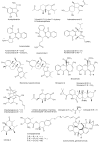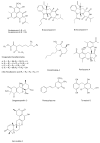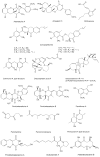Bioactive Compounds Produced by Strains of Penicillium and Talaromyces of Marine Origin
- PMID: 26901206
- PMCID: PMC4771990
- DOI: 10.3390/md14020037
Bioactive Compounds Produced by Strains of Penicillium and Talaromyces of Marine Origin
Abstract
In recent years, the search for novel natural compounds with bioactive properties has received a remarkable boost in view of their possible pharmaceutical exploitation. In this respect the sea is entitled to hold a prominent place, considering the potential of the manifold animals and plants interacting in this ecological context, which becomes even greater when their associated microbes are considered for bioprospecting. This is the case particularly of fungi, which have only recently started to be considered for their fundamental contribution to the biosynthetic potential of other more valued marine organisms. Also in this regard, strains of species which were previously considered typical terrestrial fungi, such as Penicillium and Talaromyces, disclose foreground relevance. This paper offers an overview of data published over the past 25 years concerning the production and biological activities of secondary metabolites of marine strains belonging to these genera, and their relevance as prospective drugs.
Keywords: Penicillium; Talaromyces; bioactive metabolites; chemodiversity; marine fungi.
Figures











References
-
- Jones E.B.G., Pang K.L. Marine Fungi and Fungal-Like Organisms. Walter de Gruyter; Berlin, Germany: 2012. Introduction marine fungi; pp. 1–13.
-
- Kohlmeyer J., Kohlmeyer E. Marine Mycology: The Higher Fungi. Elsevier; Philadelphia, PA, USA: 2013. p. 704.
Publication types
MeSH terms
Substances
LinkOut - more resources
Full Text Sources
Other Literature Sources
Miscellaneous

